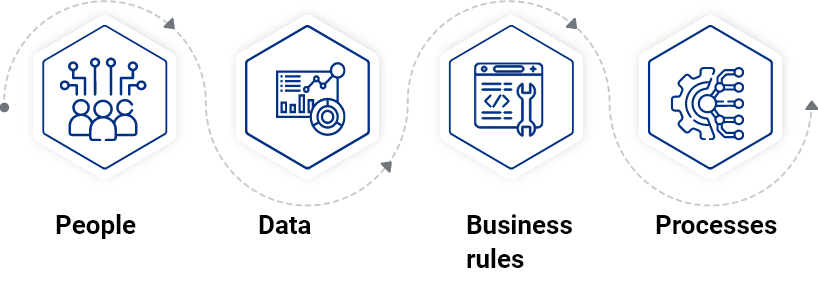Optimize the four dimensions of
process mining

Customers and businesses seek uber flexibility and responsiveness in today’s fast-paced world. Picture a scenario where a customer can effortlessly modify their credit card limit during a purchase without making that time-consuming call to customer support. Imagine an insurer drastically minimizing the time between claim submissions and their response or adjudication. Achieving success in these scenarios hinges on the ability to identify, analyze, optimize, and continuously monitor crucial business processes. Here is where the power of process mining comes into play.
Process mining is a transformative method of using advanced analysis to discover, monitor, and improve business processes. It encompasses four dimensions – people, data, business rules, and processes. Process mining can be more effective if enterprises ensure that each of these dimensions is optimized. Here’s how:

Process mining is a
transformative method of
using advanced analysis to
discover, monitor, and
improve business processes.



People


USD
40 billion
Yearly cost of non-health
insurance fraud
The effectiveness of the same process steps can vary significantly when executed by different individuals. For instance, some users experience multiple rejections of their tax documents, while others are able to secure acceptance on their very first attempt. This disparity often arises from user errors or oversights. Process mining provides a valuable tool to unearth the root causes behind these discrepancies. With this insight, organizations can empower their processes to proactively manage such errors through automation, enhancing their overall efficiency.
Data


The total cost of insurance fraud (non-health insurance) is estimated to be more than USD 40 billion annually in the United States. Process mining can help insurance companies monitor and detect fraud, provided the quality of data is consistent and accurate. For example, insurers can unearth fraudulent claims by analyzing transaction data points like lag time between process steps, multiple claim submissions, payment information, etc. Enterprises that undertake steps such as accurate data logging and analysis, data cleaning, enrichment, and validation to ensure that the data is consistent, complete, and accurate can improve the quality and utility of data. This can help improve processes, generate compelling insights, and make better decisions.


Business Rules


Process mining in the
insurance industry helps
eliminate outdated rules and
unnecessary verifications,
streamlining processes and
improving efficiency.
In the ever-evolving insurance industry, rules that were once standard may now be considered redundant, and the associated verifications could be seen as unnecessary. For instance, if majority customer referrals consistently proceed to the next stage without any issues, the verification step can be eliminated. Additionally, users might introduce manual steps that deviate from automated processes, causing delays and inefficiencies. Process mining plays a crucial role in identifying these extraneous activities and facilitating their removal. It can also pinpoint essential steps that should be added or automated, ultimately enhancing overall process efficiency.
Processes


Customers want frictionless support journeys with little back-and-forth. For example, customers who have submitted claims do not like delays in claim processing nor prefer to explain their situation to multiple agents multiple times. They expect call center agents to know the current situation and have concrete answers. Streamlining processes by adding and eliminating tasks, optimizing the combination of data, people, and business rules can result in better process efficiency.
By ensuring that these pillars of process mining are optimized, enterprises can identify bottlenecks or inefficiencies, gain deeper insights into process performance, and implement improvements.
Reach out to us to learn how process mining can benefit your enterprise.
